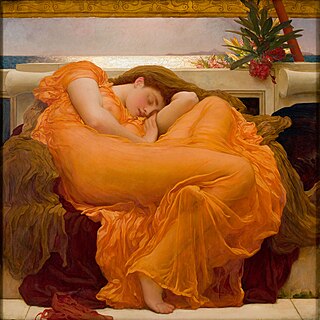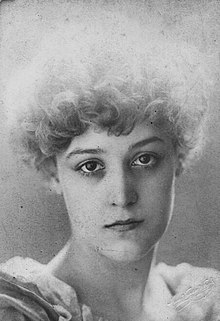Painting of Woman Sleeping Wearing an Orange Dress
| Flaming June | |
|---|---|
 | |
| Artist | Frederic Leighton |
| Medium | Oil on canvas |
| Dimensions | 120 cm × 120 cm (47 in × 47 in) |
| Location | Museo de Arte de Ponce, Ponce, Puerto Rico |
Flaming June is a painting by Sir Frederic Leighton, produced in 1895. Painted with oil paints on a 47-by-47-inch (1,200 mm × 1,200 mm) square canvas, it is widely considered to be Leighton's magnum opus, showing his classicist nature. It is thought that the woman portrayed alludes to the figures of sleeping nymphs and naiads the Greeks often sculpted.
Flaming June disappeared from view in the early 1900s and was rediscovered in the 1960s. It was auctioned shortly after, during a period of time known to be difficult for selling Victorian era paintings, where it failed to sell for its low reserve price of US$140 (the equivalent of $1,126 in modern prices). After the auction, it was promptly purchased by the Museo de Arte de Ponce in Ponce, Puerto Rico, where it currently resides.
Appraisal [edit]
Flaming June was first begun as a motif to adorn a marble bath in one of Leighton's other works, Summer Slumber. He became so attached to the design that he decided to create it as a painting in its own right.
The funereal solemnity of Michelangelo's monumental nude has been considerably warmed up, by the Victorian painter, in the act of appropriating and adapting it. Leighton has arranged matters in such a way that, although clothed, his somnolent girl's many charms are alluringly displayed for the delectation of the viewer – who is implicitly put in the position of a voyeur... Her cheeks are flushed, reddened with a blush suggesting that somehow she knows she is being watched, even though she is sleeping.[1]
According to art historian Andrew Graham-Dixon "her pose is loosely modelled on that of Michelangelo's famous statue of Night, in the Medici Tombs in Florence, which Leighton regarded as one of the supreme achievements of Western art."[1] The position of the sleeping woman gave Leighton a great deal of trouble. He made several preliminary sketches to determine the way in which she should lie; in particular he had difficulty making the angle of her right arm look natural. His studies show that the picture went through at least four evolutionary sketches before Leighton came to the end result. Out of these studies, four are nude and one is draped.[2] The draped figure looks the least lifelike, demonstrating Leighton's claimed need to draw from a naked model to achieve a fidelity to nature.
The toxic oleander branch in the top right possibly symbolizes the fragile link between sleep and death.[3]
Flaming June has become Leighton's most recognisable picture. Samuel Courtauld, founder of the Courtauld Institute, called it "the most wonderful painting in existence".[4] The realism of the transparent material worn by the sleeping woman, the stunningly rich colours and the perfectly recreated marble surround are characteristic of Leighton's work, as is his use of natural light. He allows the sunset in the background to appear as molten gold.[5]
Provenance [edit]
The painting's first owners, The Graphic magazine, bought it to create a high-quality reproduction which was given away as a Christmas gift in 1895. When Leighton died in January 1896 it was put in their office window which was passed by the funeral procession. It was loaned to the Ashmolean Museum in early 1900s; its whereabouts after this are unknown. The painting was rediscovered in a Battersea home in the early 1960s, boxed in over a chimney. Andrew Lloyd Webber saw it soon afterwards in a shop on the Kings Road, but his grandmother refused to lend him the £50 asking price, stating: "I will not have Victorian junk in my flat".[4]
In 1963 Luis A. Ferré – the noted Puerto Rican industrialist and politician, who would be elected governor five years later – was on a trip around Europe, engaged in purchasing paintings and sculptures for the Museo de Arte de Ponce in Puerto Rico, which he had founded. "It's extremely curious to know that this work of such late Victorian importance was bought in Amsterdam by Luis A. Ferre for less than $1,000 dollars in 1960."[6]
Once it was part of Museo de Arte de Ponce's collection, it became its symbol and most recognized artwork. Since then, the painting has been loaned to important museums around the world including Museo del Prado in Madrid in 2008, the Staatsgalerie Stuttgart in Germany in 2009 and in the Frick Collection in New York City in 2015.[7]
In 2015 an original pencil and chalk study for the painting – the model's head – was found on the back of a bedroom door in the mansion inherited by Bamber Gascoigne after the death of his great aunt Mary Innes-Ker, Duchess of Roxburghe.[8]
In 2016 the painting was loaned to the Leighton House Museum in Kensington, and was displayed in the studio where it was created.[4] [9] [10]
Models [edit]

Dorothy Dene in the 1880s
While the body of the woman remains a mystery, there is speculation that the face is that of either of Leighton's two favourite models in the 1890s, Dorothy Dene[11] [12] or Mary Lloyd.[13] [14]
Mary Lloyd was the daughter of an impoverished country squire. She came to London and established a highly successful career as an artist's model, posing only for the head and hands, and not nude – an important distinction. She started posing for Leighton in about 1892, was requested to come to pose in January 1895 for Leighton's Lachrymae (1894–1895). She is probably also the model for his 'Twixt Hope and Fear (c. 1895).
References [edit]
- ^ a b Graham-Dixon, Andrew (5 June 2005). "ITP 266: Flaming June by Frederic Leighton". The Sunday Telegraph.
- ^ Cf. T. Barringer & E. Prettejohn, Frederic Leighton: Antiquity, Renaissance, Modernity, Yale University Press (1999), s.v. "Flaming June".
- ^ "Leighton, Frederic: Flaming June (1895)". The Independent. 25 April 2008.
- ^ a b c Maev Kennedy (20 June 2016). "Leighton's Flaming June to go on display in studio where it was painted". The Guardian.
- ^ A. Weidinger, Magnificent Extravagance – Frederic, Lord Leighton's Flaming June 1894–95, Belvedere (2010), passim.
- ^ Flaming June Sketch Rediscovered After 100 Years of Silence. Joey Medrano. Puerto Rico Art Review. 2 May 2015. Accessed 30 January 2019.
- ^ Leighton's Iconic Painting Flaming June on View in New York City for the First Time: June 9 through September 6, 2015. Press Release 256. 4 May 2015.
- ^ "Pre-Raphaelite study behind door in English mansion", The Guardian, 1 May 2015, archived from the original on 18 May 2015, retrieved 3 May 2015
- ^ "Jimmy Page welcomes Flaming June painting back to Kensington". Evening Standard. 2 November 2016.
- ^ "Flaming June will brighten the darkness". The Times.
- ^ Monahan, Patrick. "The Strange Journey of One of the World's Most Famous Paintings". Vanity Fair.
- ^ "Dorothy Dene: Lord Leighton's secret lover?". The Daily Telegraph.
- ^ Jill Berk Jiminez (15 October 2013). Dictionary of Artists' Models. Routledge. pp. 593–. ISBN978-1-135-95914-2.
- ^ "Apollo Magazine". Archived from the original on 2 January 2013. Retrieved 18 January 2017.
Bibliography [edit]
- Barringer, Tim & Prettejohn, Elizabeth, Frederic Leighton: Antiquity, Renaissance, Modernity (Paul Mellon Center for Studies in British Art), Yale University Press (1999). ISBN 978-0-300-07937-1
- Barrington, Russel, The Life, Letters and Work of Frederic Leighton, 2 Voll., BiblioBazaar (2010). ISBN 978-1-143-23340-1
- Weidinger, Alfred, Magnificent Extravagance – Frederic, Lord Leighton's Flaming June 1894–95. Sleeping Beauty. Masterpieces of Victorian Painting from Museo de Arte de Ponce. Edited by Agnes Husslein-Arco and Alfred Weidinger. Belvedere, Vienna 2010. ISBN 978-3-901508-84-4
External links [edit]
- Frederic-Leighton.org 114 works by Frederic Leighton
- Discussion by Janina Ramirez: Art Detective Podcast, 29 Jan 2017
Source: https://en.wikipedia.org/wiki/Flaming_June
0 Response to "Painting of Woman Sleeping Wearing an Orange Dress"
Post a Comment